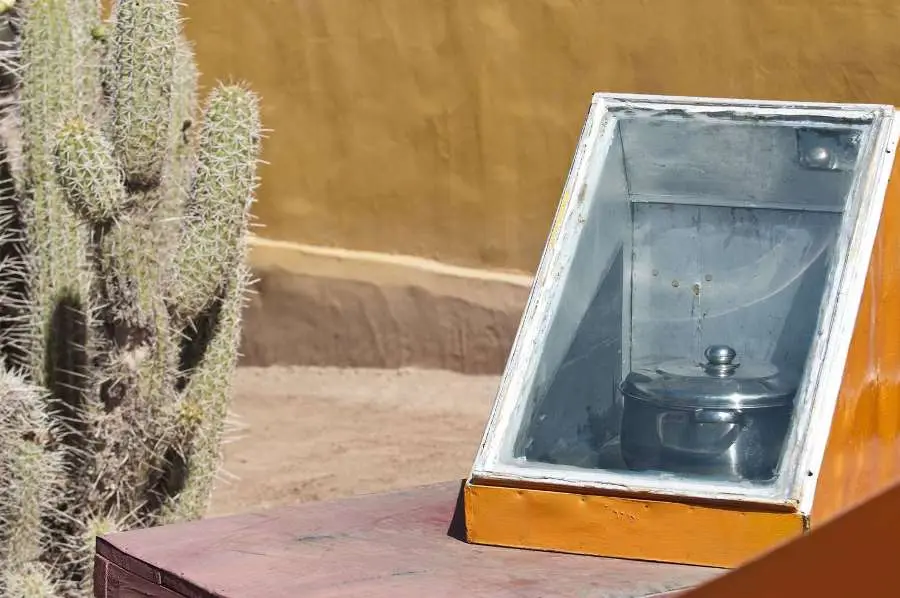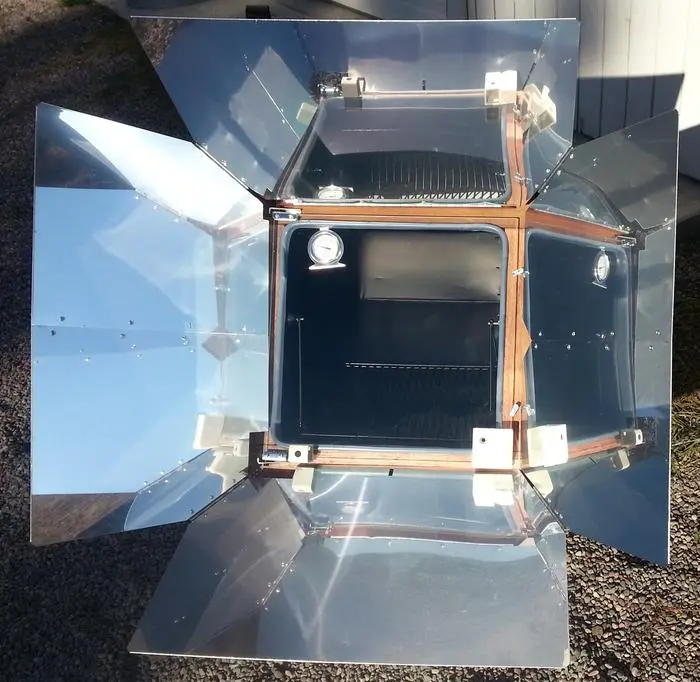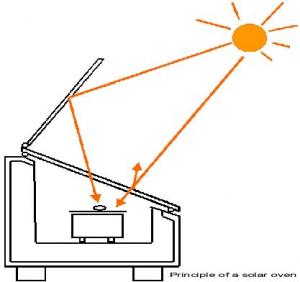We independently review everything we recommend. When you buy through our links, we may earn a commission.
What is a Solar Oven? And How Does It Work?

There has been a lot of emphasis on using alternative energies and many entrepreneurs have been trying to make household appliances and kitchenware’s environmentally friendly as well.
There is a myriad of products available ranging from solar watches, solar lights, radios etc. And one such product that uses solar energy for cooking is the solar oven, fondly called a sun oven.
What is a Solar Oven?
A solar oven (also known as sun oven) is a cooking oven that makes use of heat from the sun to cook food. It works by heating the food with solar energy. It is kept in the open, where it can receive an ample amount of sunlight. This is surely a direction in the green friendly zone of using an energy that is both abundant and environment friendly.
Many people in many countries use firewood which has resulted in depletion of forest areas. Sun ovens are not as popular as they should be, partly owing to the higher costs and awareness among people. While most kitchen appliances like the air fryer, pressure cooker, microwave and more all use electricity, A solar oven is a great way to save energy.

Who came up with the idea of sun cooking?
Solar energy was harnessed as far back as the Roman, Greek and Chinese civilizations, but it was not used as a means to cook food. It was not until 1767 when Horace De Saussure, a French-Swiss physicist came up with the concept of cooking with the help of sun’s thermal energy.
How Solar Ovens works

A solar oven basically consists of a box with adjustable lids and stands plus an inside food chamber that contains the food to be cooked.
The heat gain for the oven takes place following the greenhouse effect. The visible sunlight passes through a transparent material like glass or plastic. This light is reflected and absorbed by the materials comprising the interior of the box.
There is a dark surface just below the pot containing the food. This surface absorbs the visible light of sun and converts it into longer wavelengths which cannot penetrate the glass surface and go outside the box. This trapped heat is conducted by the pot to heat the food by conduction.
The glass surfaces in good sun ovens are usually in a way so that it receives the sunlight directly. This will make it more efficient.
If there are multiple reflectors present, then it can redirect back the reflected light into the box and can raise the cooking temperature.
From the second law of thermodynamics, we know that heat travels from a higher temperature region to a lower temperature region. And following this principle there can be losses inside the box via conduction, convection and radiation.
The absorption plate is raised from the bottom and separated using insulating spacers to prevent conduction losses. Transparent glazing is used to trap most of the heat from escaping outside the sun oven by radiation.
Disadvantages of most sun ovens
- Solar cookers or sun ovens usually take a long time to cook meals compared to fuel-based cooking systems.
- The cooking is at its best mainly during the hottest hour of the day. Now this can get heavily affected on cloudy days or partly cloudy days and during the winter months.
- Sun oven cooked food needs to be consumed soon after it is cooked. They do not retain the heat after some time, so most people who would like to eat it hot and fresh do not have the choice in this case.
In the reflector type of sun ovens reflectors get highly affected with strong winds. When the reflector’s angles change or its line of operation shifts from the point where the sun’s intensity is the most, the cooking efficiency reduces and it takes longer to cook the food.
For cooking the simplest food by a sun oven, it is important to grasp the techniques since it is not easy as it is for normal food.
Usually, simple food items which are devoid of oil and those that do not require deep frying can be cooked with the help of sun ovens. But thick food or fried food items cannot be prepared by a sun oven.
How to make solar ovens more efficient in winter
It becomes difficult to cook on winter days because the sun is closer to the other hemisphere.
To overcome this problem, you should tilt the sun oven so that it is almost in a horizontal position.
- You can get a plastic square from any hardware store and then tilt the sun oven after you place the square on the glass and then tilt the cooker at an angle so that you are no longer in a position to see its shadow.
At this point, the cooker is properly focused to intensify the sun’s heat at a particular point to aid cooking.
For those food items which make us wait longer, we can adjust the focus twice or thrice.
This would ensure that the sun’s heat stays concentrated for a longer period of time. In this way, the muffins and cookies can be cooked easily.
You can overcome the problem of undercooked food by trying to cook between 10 a.m. to 2 p.m. during winter months usually.
So that the food remains hot for a longer period of time in winter months, you should try to insulate it by placing piles of old leaves or an old blanket around it.
The glass lid and the box of the oven should not even allow the passing of a thin sheet of paper. If it does then the heat retention design has not been taken care of properly.
Buying Guide
Check for angle adjustment possibility
People living in the northern hemisphere should always look for options of angle adjustment possibilities in their sun oven.
During winter, the rays of sunlight are not perpendicular or direct and due to greater distance of the sun, the light is diffused, hence, do check the elevation of your place and simply add 15 degrees to that in winter and change your angle.
Check portability
Most sun ovens are heavy, but select one which is easy for you to carry from one section of your home to another.
Reflecting technology
Polyisocyanurate insulation material is very good for sun ovens. Try and avoid using reflectors that are devoid of vinyl coating. They do not stay effective for very long because this vinyl layer fades off after some time. Check the space inside the oven, whether it is enough to contain your cooking pots or not.
The lids are usually something that creates trouble, so check their hinge attachments.
Ask if the aluminum used in reflectors is enamel coated or not, this would ensure that they do not rust easily. Reflectors are optional in many sun oven companies, but you should always go for it, because in the northern hemisphere, it will result in very poor heating without them.
Using a sun oven makes us contribute, though in a small way to help our current energy situation and save some energy as it all adds up.
Is a solar oven right for you?
If you want to contribute even to a small extent in the energy crisis period and save some energy, then go for a sun oven which makes use of clean and renewable energy from the sun.
A sun oven may be a little different to use in the initial days but with unreliable LPG supply especially in India, this may be a good option to try out with so many sunny days. More research work is invited in this field and there has been quite a number of improvements in the models that are now reaching the market.
Before buying a good sun oven you can also choose to make a simple solar cooker for your home. It is simple to construct a sun oven with simple readily available materials. In this way you can test the working efficiency of your sun oven and then you may have a better understanding while buying a sun oven for your home.
Conclusion
The more people start using alternative energy solutions be it even minute it will add up to make a big difference overall.
So, the next time you go shopping for a new cooking range, maybe looking into a sun oven might open up more choices and solutions in how you use energy.
External References
- Features of sun oven – Sunoven.com
- Solar cooking history – solarcooker-at-cantinawest.com
